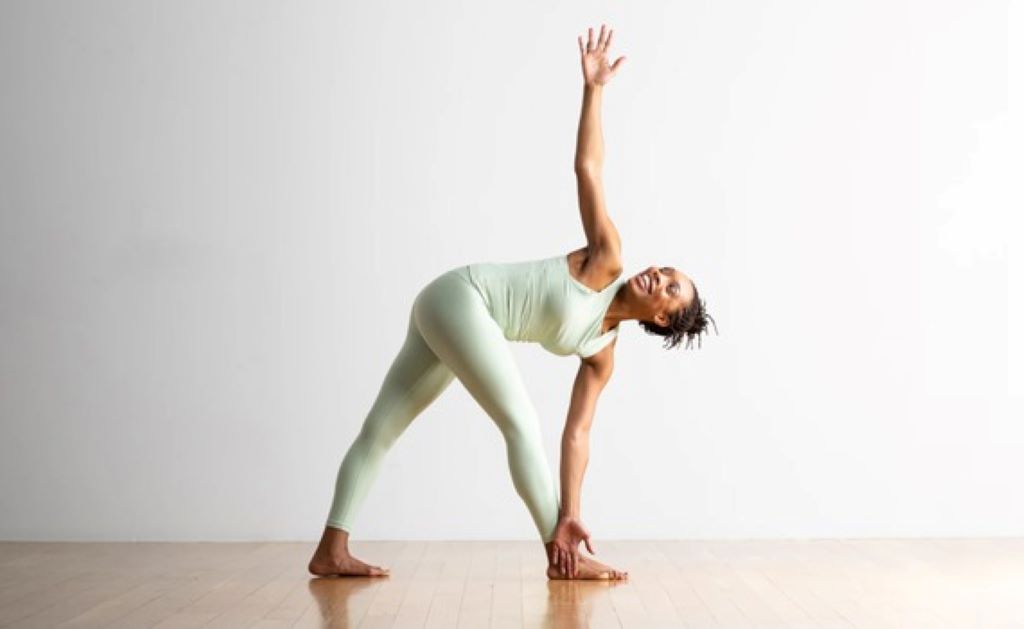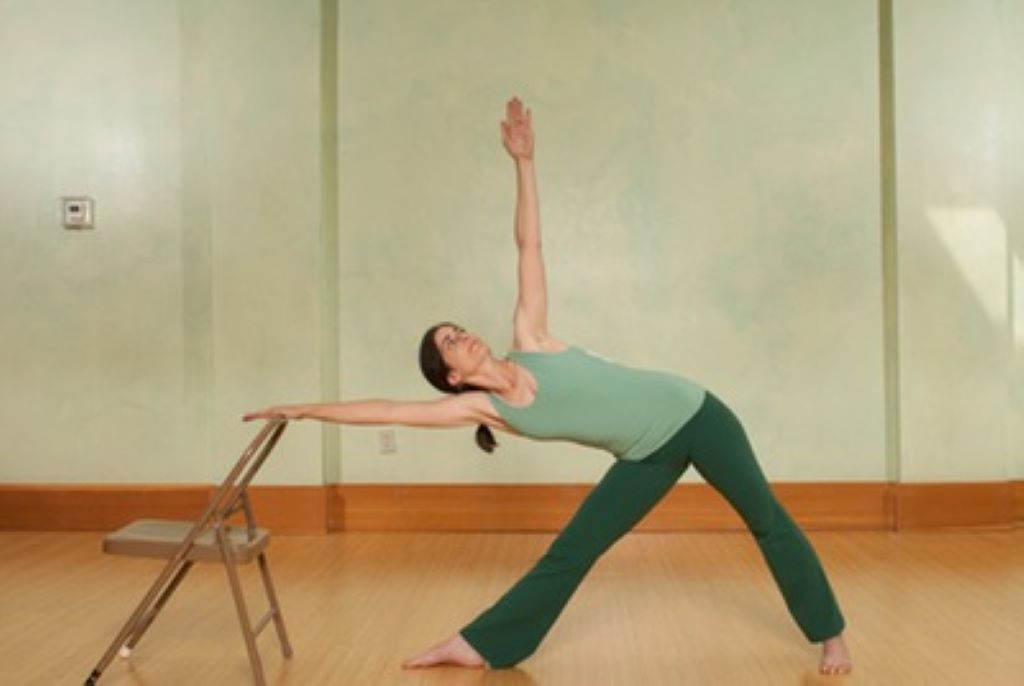
Scoliosis, a condition that causes the spine to curve abnormally, can lead to discomfort, postural issues, and even chronic pain. Fortunately, yoga offers some powerful corrective tools to help manage and reduce the impact of scoliosis, one of which is the triangle pose. Proper triangle pose alignment can be particularly beneficial, as it helps to stretch and strengthen the muscles along the sides of the body, promoting better posture and spinal health.
When practicing triangle pose (Trikonasana), alignment is key. Proper form not only promotes overall spinal health but can also help alleviate the discomfort that comes with scoliosis. If you’re new to yoga or have been practicing for a while, understanding the alignment cues for this pose is essential.
Explore E-Daily Workout for expert guidance on perfecting your triangle pose, especially if you’re working with scoliosis or other spinal concerns. But before diving in, let’s explore the detailed alignment cues that will make a world of difference in your practice.
What Is Scoliosis and How Does It Affect the Body?
Scoliosis is characterized by an abnormal lateral curve of the spine, often forming an “S” or “C” shape. It can occur during childhood or adolescence, but many adults also live with mild scoliosis that can worsen with age.
The effects of scoliosis on posture, balance, and muscle strength are profound. Uneven hips, shoulders, and spinal misalignment may cause tightness or discomfort, especially after sitting for long periods or engaging in physical activity. By incorporating targeted yoga poses like triangle pose into your routine, you can help address these issues and improve the body’s alignment.
Understanding Triangle Pose (Trikonasana) for Scoliosis
Triangle pose is a foundational yoga asana that stretches the hamstrings, opens the hips, and strengthens the legs. For people with scoliosis, triangle pose offers an excellent opportunity to balance and align the body. However, alignment is paramount—incorrect form may exacerbate your condition rather than relieve it.
So, let’s take a closer look at the steps and cues that can help you achieve proper alignment in triangle pose.
Key Alignment Cues for Triangle Pose
Feet Placement:
Start by standing with your legs wide apart, typically 3-4 feet, depending on your body size. Turn your right foot out 90 degrees and your left foot slightly inward. This ensures a stable base and creates the correct alignment for the spine.
Engaging the Legs:
The legs need to be actively engaged in this pose, especially for those with scoliosis. Press firmly into the outer edges of both feet, making sure your arches are lifted and your knees are not locked. Engaging the legs helps stabilize the pelvis and spine, preventing misalignment as you stretch.
Hip Alignment:
The most important aspect of triangle pose for scoliosis is keeping the hips square to the front of the mat. If you have a lateral curve, ensure that your pelvis does not tilt excessively to one side. You may need to adjust your stance slightly wider or narrower depending on how your hips feel.
Spinal Engagement:
Lengthen your spine as you hinge at the hips, and reach your torso over to your right leg. Imagine your spine growing longer with each breath. Avoid collapsing into your lower back, which could worsen your scoliosis. Instead, use your core muscles to maintain a neutral spine as much as possible.
Upper Body Position:
Your torso should be aligned with your legs, and your upper arm should be reaching straight toward the ceiling. Make sure the chest is open and not compressed. This will help open up the side of the body that may be more restricted due to your scoliosis.
Neck and Head Position:
Gaze upward at your top hand if your neck feels comfortable doing so, or gaze straight ahead if it doesn’t. Keep the neck long and avoid letting it crunch or strain.
Triangle Pose and Scoliosis: Benefits for Spinal Health

Practicing triangle pose regularly can bring numerous benefits to those with scoliosis, including:
- Improved Spinal Flexibility: The stretch and opening of the spine in triangle pose can help increase flexibility, reducing stiffness in the back and improving posture.
- Enhanced Core Strength: The pose activates your core muscles, which are crucial for stabilizing the spine and supporting healthy posture.
- Balanced Hips and Shoulders: The alignment work in triangle pose helps balance the hips and shoulders, which is often a challenge for individuals with scoliosis due to unevenness in their posture.
- Relief from Back Pain: Regular practice of triangle pose helps to relieve tension in the lower back, which is a common area of discomfort for scoliosis sufferers.
Utilizing an Yoga Apps for Scoliosis Management
In today’s digital age, you don’t need to go to a yoga studio to practice triangle pose. Whether you’re at home or traveling, there are numerous tools that can guide you in your yoga practice. One such tool is a yoga app.
Apps can offer step-by-step video guidance on triangle pose, along with modifications for scoliosis. Many apps also provide progress tracking, so you can monitor improvements in flexibility and alignment over time. By having access to these resources, you can practice triangle pose effectively and safely, even if you have limited experience with yoga. Check out the android yoga app guide to find an app that suits your needs.
How to Integrate Triangle Pose into Your Routine
To see the full benefits of triangle pose for scoliosis, consistency is key. Here’s how to integrate this pose into your daily routine:
- Start Slow: If you’re new to yoga, start with shorter sessions and focus on mastering the alignment cues. Over time, you can increase the duration and depth of your stretches.
- Daily Practice: Try to practice triangle pose at least 3-4 times per week. Consistent practice will help improve flexibility, strength, and posture.
- Pair with Other Poses: Combining triangle pose with other scoliosis-friendly yoga poses—like cat-cow, child’s pose, or downward dog—can create a balanced and effective routine.
Final Thoughts
Triangle pose is an incredibly beneficial tool for those dealing with scoliosis. When performed with the proper alignment, it can help relieve pain, improve posture, and support long-term spinal health. If you’ve been struggling with scoliosis-related discomfort, give triangle pose a try and see how these alignment cues can enhance your practice.
Summary
Scoliosis can cause significant discomfort and postural challenges, but practices like triangle pose can make a real difference. Understanding proper alignment and utilizing helpful resources like yoga apps can guide you on your journey to better spinal health. Through consistent practice and mindful attention to detail, triangle pose can aid in correcting scoliosis, enhancing flexibility, and relieving pain.
Read More:
From Heart Health To Anti-Aging: The Numeric Wonders Of Trans-Resveratrol
Featured Image Source
